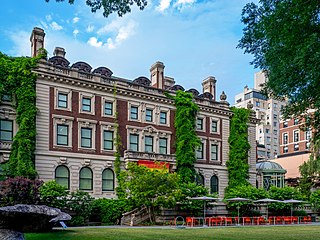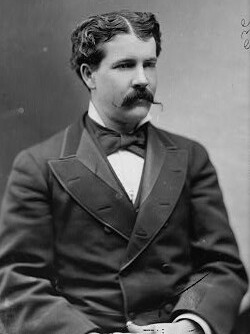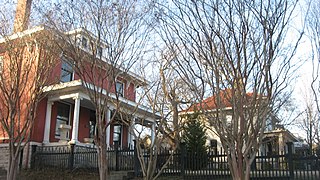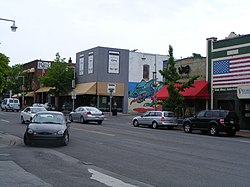
Forest Hills is a city in Davidson County, Tennessee. The population was 5,038 at the 2020 census and 4,866 in a 2018 estimate.
Ward–Belmont College was a women's college, also known at the time as a "ladies' seminary," located in Nashville, Tennessee, on the grounds of the antebellum estate of Adelicia Hayes Franklin Acklen Cheatham.

Carnegie Hill is a neighborhood within the Upper East Side, in the borough of Manhattan in New York City. Its boundaries are 86th Street on the south, Fifth Avenue on the west, with a northern boundary at 98th Street that continues just past Park Avenue and turns south to 96th Street and proceeds east up to, but not including, Third Avenue. The neighborhood is part of Manhattan Community District 8.
Grymes Hill is a 374 feet (114 m) tall hill formed of serpentine rock on Staten Island, New York. It is the second highest natural point on the island and in the five boroughs of New York City. The neighborhood of the same name encompasses an area of 0.894 square miles (2.32 km2) and has a population of 8,263 people. The hill also includes parts of the Silver Lake neighborhood. The area includes part of ZIP Codes 10301 and 10304.
Green Hills is an affluent neighborhood in Nashville, Tennessee, United States. Green Hills is located south of downtown Nashville on Hillsboro Pike.
Penn Valley is an unincorporated community located within Lower Merion Township, Pennsylvania, United States. Penn Valley residents share a zip code with Merion, Narberth, or Wynnewood because the community does not have its own post office. However, Penn Valley is a distinct community whose civic association demarcates its boundaries with iconic signs featuring William Penn and a farmhouse in blue or red on white, dating from 1930.

Joseph Hayes Acklen was an American politician who served as a U.S. Representative from Louisiana from 1878 to 1881.

Belmont Mansion, also known as Acklen Hall, and originally known as Belle Monte, Belle Mont or Belmont, is a historic mansion located in Nashville, Tennessee. It was built by Joseph and Adelicia Acklen to serve as the center of their 180-acre summer estate in what was then country outside the city, and featured elaborate gardens and a zoo. They lived much of the rest of the year on her plantations in Louisiana.

College Hill is a neighborhood of the City of St. Louis, Missouri. The name College Hill was given to this area because it was the location of the Saint Louis University College Farm. This area, bounded generally by Warne Ave., O'Fallon Park, I-70, Grand Boulevard, and W. Florissant Ave., was acquired by the University for garden and recreation purposes in 1836. It was subdivided in the early 1870s.

Roger Williams University was a historically black college in Nashville, Tennessee. It was founded in 1866 as the Nashville Normal and Theological Institute by the American Baptist denomination, which established numerous schools and colleges in the South. Renamed for Roger Williams, the founder of the First Baptist Church in America, it became the largest Baptist college in the area for educating African Americans. It was founded in a period when Protestant mission groups sponsored numerous educational facilities for freedmen in the South.

Adelicia Hayes Franklin Acklen Cheatham, best known as Adelicia Acklen, became the wealthiest woman in Tennessee and a plantation owner in her own right after the 1846 death of her first husband, Isaac Franklin. As a successful slave trader, he had used his wealth to purchase numerous plantations, lands, and slaves in Tennessee and Louisiana. Acklen later in 1880 sold four contiguous plantations in Louisiana as one property. These have formed the grounds of the Louisiana State Penitentiary since 1901.

William Hayes Ackland was an American lawyer, writer, and art collector from Nashville, Tennessee. He lived most of his life away from Tennessee, in Washington, DC, and various social spots, traveling to England annually for its social season. The Ackland Art Museum at the University of North Carolina Chapel Hill was begun with his collection.
Edwin Augustus Keeble was an American architect who was trained in the Beaux-Arts architecture tradition. He designed many buildings in Tennessee, including homes, churches, military installations, skyscrapers, hospitals and school buildings, some of which are listed on the National Register of Historic Places. He is best known for Nashville's landmark Life and Casualty Tower built in 1957 which was the tallest commercial structure in the Southeastern United States at that time. It reflected an architectural turn to modernism and was one of the first buildings emphasizing energy efficiency.

Burlington, also known as the Elliston-Farrell House, was a historic mansion on a plantation in mid-town Nashville, Tennessee, US. It stood on modern-day Elliston Place.
William R. Elliston (1815–1870) was an American planter, slaveholder and politician. He served as a member of the Tennessee House of Representatives from 1845 to 1847. He owned Burlington Plantation in what is now Nashville, Tennessee. An investor in railroads and real estate, Elliston entered his horses in equestrian competitions. The former plantation property was later developed as modern-day Centennial Park, Vanderbilt University and West End Park.
Thomas Isham Webb Jr., (1880–1975) was a Tennessee attorney who excelled at golf and won the 1913 Tennessee state amateur. He was one of Tennessee's earliest golfers at the cusp of the sport's popularity in the United States near the beginning of the twentieth century. While a student at Vanderbilt University in 1896, Webb constructed a rudimentary nine-hole golf course next to University campus and the group attracted like-minded golf enthusiasts. Prominent citizens became interested and eventually formed a golf club which still exists over a century later. In 1901, Webb was a charter member of the Nashville Golf and Country Club where Grantland Rice, Webb's Vanderbilt classmate, first became interested in golf. The club was later renamed "Belle Meade Country Club" and Webb was the club golf champion in 1913 and 1917. At the time of his death at age 95, Webb was celebrated as club's oldest living member. He endowed an annual trophy for the Belle Meade Junior Golf championship; a room named for him was dedicated by in 1976 by sportswriter Fred Russell.
Joseph Alexander Smith Acklen was an American lawyer, planter, and veteran of the Texas Revolution, best known as the second husband of Adelicia Hayes Franklin Acklen Cheatham, and the father of U. S. Representative Joseph H. Acklen.

William Ridley Wills II is an American author and historian living in Nashville, Tennessee, who has authored 28 historical and biographical books as of 2021. He received the Tennessee History Book Award in 1991 for his first book, The History of Belle Meade: Mansion, Plantation and Stud. He is a past president of the Tennessee Historical Society and in 2016, was given an Honorary Doctor of Humane Letters from The University of the South. He is a former executive of a company founded by his grandfather, the National Life and Accident Insurance Company and was on the boards of trust of Vanderbilt University and Montgomery Bell Academy, a prep school for boys in Nashville.
West Meade is a neighborhood in Nashville, Tennessee. It is governed by the Metropolitan Council of Nashville and Davidson County, due to the fact that the government of Davidson County is consolidated with that of Nashville

Belmont–Hillsboro Historic District is a historic neighborhood in Nashville, Tennessee. It was listed on the National Register of Historic Places listings in Davidson County, Tennessee (NRHP) in 1980. The area homes are now protected by a Belmont-Hillsboro Neighborhood Conservation Zone which creates rules for homeowners within the district.












